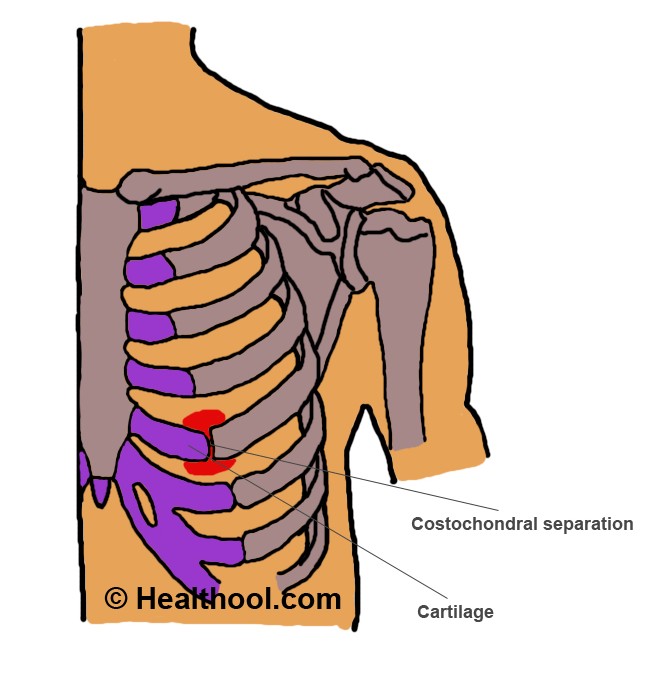Costochondral Separation
Last reviewed by Dr. Raj MD on January 12th, 2022.
What is Costochondral Separation?
This medical condition occurs when one of your ribs becomes separated from your sternum. Your sternum is another name for your breastbone, which is the long flat bone that is located in the center of your chest, is shaped like a necktie, and is approximately an inch wide and six inches long.
Your sternum also helps to protect the vital organs of your chest and stabilize your thoracic skeleton. Your ribs are connected to your sternum through the costochondral joints, which are the joints between the costal cartilage and your ribs in front of your rib cage. It is also known as a separated rib in the medical field.
Rib cage Anatomy
You have twelve pairs of ribs but only ten pairs are attached to your sternum. The other two pairs are called floating ribs and are not attached to your sternum. The ribs that are attached to your sternum are done so by the costochondral joint.
Symptoms of Costochondral Separation
There can be a variety of symptoms that you might experience when you suffer from costochondral separation. Here are some of the more common symptoms you might experience:
- Sudden onset of pain at the point where your rib connects with your costochondral joints
- You might also hear a popping sensation the moment this happens
- The pain may initially subside due to the adrenalin rush, which is common in any accidents that result in an impact. However, the pain will become worse as your adrenaline levels come back down to normal.
- Movement aggravates your pain and because of this your level of activity is reduced and your quality of sleep may also be affected
- Taking deep breaths or coughing can also aggravate the pain
- Having difficulty in breathing
- Coughing
- Sneezing
The pain that you experience may only happen if you do any activities that aggravate the condition or it could also occur when you are resting or trying to sleep. It can also make it worse if you start to cough, sneeze, laugh, or take deep breaths.
Costochondral Separation Pictures
Picture of Costochondral Separation
What Causes Costochondral Separation?
When a person suffers from costochondral separation there can be many different causes but usually it due to some type of blunt force to your chest. These can include:
- Vehicle accidents in which your chest suddenly impacts the steering wheel hard or the impact of the accident is on your side
- Crush injuries in which a heavy object lands directly on your chest
- Injuries from sports such as a heavy tackle
- Falling off a ladder or roof from considerable heights and landing on your side
- Violent assaults
- Getting hit by an object such as a baseball bat in your chest
- Coughing violently
- Excessive twisting of your trunk
The separation occurs when your rib bone becomes separated from the cartilage. When you have costochondral separation your rib points upward into the rib or tissue that is directly above it. Sometimes if a direct blow caused your case of costochondral separation can also cause rib fractures.
Diagnosis
When you go to the emergency room the physician will first do a physical exam to identify any potential injuries. If it is thought that you have suffered from costochondral separation the physician will do a compression of your rib or move your arms in certain ways to see if they can trigger any symptoms or pain that could indicate costochondral separation.
They may also feel along your sternum to see if you have any swelling or tenderness. If you have pain when they do this maneuver they will have chest x-rays taken to make a final diagnosis. They will do both lateral and frontal views of your sternum to rule out any other medical conditions.
Treatment for Costochondral Separation
Once you have been diagnosed with costochondral separation the best treatment is to rest and not do any physical activity, lift anything heavy, participate in any spots in order to let it heal. For pain relief you may be given a prescription for pain medication or the physician will have you take over-the-counter pain medication along anti-inflammatory medications.
You can also use an icepack on the injury for ten to fifteen minutes two to three times a day. These medications will help ease your pain and make breathing a little easier. Some physicians may use high volt electro stimulation to help relieve the pain and increase your healing process.
Having an ultrasound will help to increase circulation to the area to also decrease the pain and increase the healing time. Once the injury has almost healed you can use a heating pad to help increase the flow of your blood so the blood can deliver more nutrients to the area. For the injury to heal completely it can take two to three months.
Complications
When a person has costochondral separation it can make you susceptible to costochondritis. This medical condition is characterized by inflammation at the junction of the costal cartilage and the rib. Some people feel that when they experience the pain on the left side of their chest that this condition causes is a sign of a heart attack.
